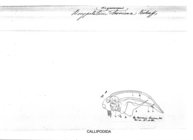MilliBase
MilliBase taxon details
Dorypetalum bosniense (Verhoeff, 1897)
1025296 (urn:lsid:marinespecies.org:taxname:1025296)
accepted
Species
Dorypetalum degenerans bosniense (Verhoeff, 1897) · unaccepted
Lysiopetalum degenerans bosniense Verhoeff, 1897 · unaccepted
(of Lysiopetalum degenerans bosniense Verhoeff, 1897) Verhoeff, K. W. (1897). Über Diplopoden aus Bosnien, Herzegowina und Dalmatien. II.Theil: Chordeumidae und Lysiopetalidae. Archiv für Naturgeschichte, 63(1): 147-156. Berlin
page(s): 152 [details]
page(s): 152 [details]
Sierwald, P.; Decker, P.; Spelda, J. (2025). MilliBase. Dorypetalum bosniense (Verhoeff, 1897). Accessed at: https://www.millibase.org/aphia.php?p=taxdetails&id=1025296 on 2025-09-13
original description
(of Lysiopetalum degenerans bosniense Verhoeff, 1897) Verhoeff, K. W. (1897). Über Diplopoden aus Bosnien, Herzegowina und Dalmatien. II.Theil: Chordeumidae und Lysiopetalidae. Archiv für Naturgeschichte, 63(1): 147-156. Berlin
page(s): 152 [details]
additional source Stoev, P.; Sierwald, P.; Billey, A. (2008). An annotated world catalogue of the millipede order Callipodida (Arthropoda: Diplopoda). Zootaxa, 1706: 1-50
page(s): 15 [details]
additional source Kime, R. D.; Enghoff, H. (2011). Atlas of European Millipedes (Class Diplopoda) Volume 1 Orders Polyxenida, Glomerida, Platydesmida, Siphonocryptida, Polyzoniida, Callipodida, Polydesmida. <em>Fauna Europaea Evertebrata.</em> 3: 1-282; June 2011.
page(s): 44; note: Raised to full speci es rank by Strasser (1974) . Hoffman & Lohmander (1964) state that a ll the nominal species of this genus might be found to merge as geographic representatives of a polytypic spec...
[details]
page(s): 152 [details]
additional source Stoev, P.; Sierwald, P.; Billey, A. (2008). An annotated world catalogue of the millipede order Callipodida (Arthropoda: Diplopoda). Zootaxa, 1706: 1-50
page(s): 15 [details]
additional source Kime, R. D.; Enghoff, H. (2011). Atlas of European Millipedes (Class Diplopoda) Volume 1 Orders Polyxenida, Glomerida, Platydesmida, Siphonocryptida, Polyzoniida, Callipodida, Polydesmida. <em>Fauna Europaea Evertebrata.</em> 3: 1-282; June 2011.
page(s): 44; note: Raised to full speci es rank by Strasser (1974) . Hoffman & Lohmander (1964) state that a ll the nominal species of this genus might be found to merge as geographic representatives of a polytypic spec...
Raised to full speci es rank by Strasser (1974) . Hoffman & Lohmander (1964) state that a ll the nominal species of this genus might be found to merge as geographic representatives of a polytypic species (degenerans). There are n ot enough records to permit a decision. However, Stoev & Enghoff (2006) still recognise seven species in the genus, including one occurring in Anatolia.
 Present
Present  Inaccurate
Inaccurate  Introduced: alien
Introduced: alien  Containing type locality
Containing type locality
